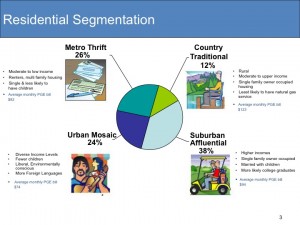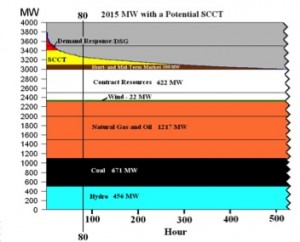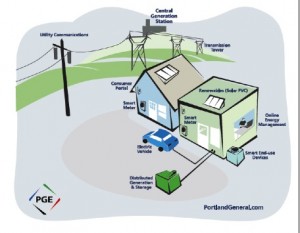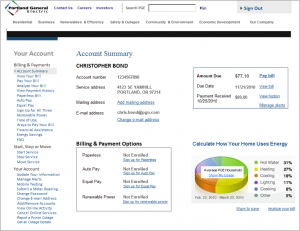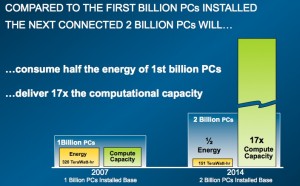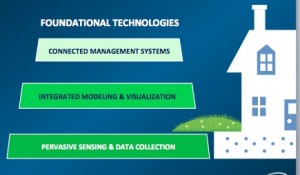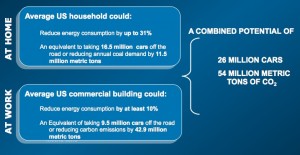Smart Grid Class #8 February 28, 2011
The eighth session of this course was devoted to the topic of how the Smart Grid intersects with the consumer. To discuss this perspective the teaching staff had invited the Bob Jenks, the Executive Director of the Citizens’ Utility Board (CUB), Lauren Shapton, PGE’s Manager of Mass Market products, and Scott Schull the director of Smart Commercial Buildings at Intel.
_______________________________________________________________________________________
Untitled presentation
Bob Jenks, Executive Director
Citizens’ Utility Board of Oregon
 Bob Jenks started off the presentations by introducing the Citizens’ Utility Board which is an advocacy group representing the residential customers of utilities. There are currently approximately 43 consumer advocate offices across the country, but most of them are supported by government, or attached to government – sometimes as an adjunct to the Attorney General’s office. CUB is a bit different in as much as it is an independent, non-profit, non-governmental agency. Most of these ombudsman’s offices focus primarily on rates, but the Citizens’ Utility Board seeks also to represent the values of Oregonian consumers.
Bob Jenks started off the presentations by introducing the Citizens’ Utility Board which is an advocacy group representing the residential customers of utilities. There are currently approximately 43 consumer advocate offices across the country, but most of them are supported by government, or attached to government – sometimes as an adjunct to the Attorney General’s office. CUB is a bit different in as much as it is an independent, non-profit, non-governmental agency. Most of these ombudsman’s offices focus primarily on rates, but the Citizens’ Utility Board seeks also to represent the values of Oregonian consumers.
Certainly Oregonians are concerned about rates, but they also care about sustainability, climate change, a broad range of things. They’re working closely with PGE to close Boardman. They take a pretty broad view of representing their customers.
The Commission had an ongoing docket open to consider the Smart Grid. PUC staff put out a proposal, which the SGO supported. CUB is a member of the SGO group. But this shocked Bob because he thought it was a “huge barrier” to the implementation of the Smart Grid. In talking with the SGO and the commission staff he came to the realization that there were two distinctive ways to see the deployment of the Smart Grid and that’s really influencing the policies that people are putting in place today. He cautioned that we have to be careful lest we allow our visions to put barriers in place to prevent the development of the Smart Grid. The case in point was that the staff proposal had advocated a position that would “ban utilities from investing in Smart Grid applications on the customers’ side of the meter”. The theory was that such an investment would stymy competition and prevent the emergence of third parties introducing innovation into the marketplace.
Bob’s reaction to this was, “this is crazy!” He cited the small Emerald PUD, which introduced an automatic turn-down during critical peak times saving customers money automatically. To Bob that was a different approach to dynamic pricing – rather than charge customers more, they automatically saved them money in ways that customers might never even notice. To Bob, this was a different way to use the power of the Smart Grid. Rather than use Smart Grid’s control to earn more money, Emerald PUD used the capability to save their customers money.
Another example that Bob cited was the imminent introduction of large numbers of electric vehicles into the system. Their energy needs would shift from petroleum to electricity. Staff wants to have Time-Of-Use pricing for EV charging, which would encourage users to charge during the off peak periods. Bob’s concern is what happens when we have 500,000 vehicles? What happens when every car plugs in at 10 PM when off peak rates kick in? The heaviest drain on the system occurs during the initial part of the charging period, which would be between 10 PM and midnight. There will be a significant load from 10 -12. That kind of predictable load can be made by managed by the utilities – quite cheaply using CCCT’s.
But another way of dealing with this is to allow the utility to control when the charging takes place. This would allow the utilities to initiate the electric vehicle charging when the typical nighttime upsurge of wind energy provides an excess (given the reduced usage overnight) of power. The utilities could optimize their use of this renewable resource while still guaranteeing that the EV’s would be charged by a specific time in the morning. Such an approach would make optimal use of the intermittent wind resource, and it would avoid having to use natural gas to fire up a CCCT to provide the additional load on the system from 10 to midnight. This requires energy management tools “on the inside of the meter”. This leads Bob to conclude “it won’t work if you prohibit the utility from investing in applications on the customers’ side of the meter”.
The rebuttal has been that “aggregators” will come in and aggregate a large number of EV owners and then will sell this DR product at a cost just below the cost of firing up the CCCT. But Bob asks, “Why wait for a 3rd party to aggregate these customers when the utility is already doing this”, and the utility is already communicating quite effectively with those same customers.
This led Bob to realize that there are a couple of competing models out there in how we set up the role of the utility. These two different perspectives reflect the regional differences in the development of utilities across the US.
In many of the eastern markets utilities sold off generation and are no longer integrated utilities. This structure is more suited to a deregulated market where the assets and services are disconnected and can compete individually. In the west, however, many of the utilities are still integrated and own their own generation. They compete on the basis of a bundle of generation, transmission and distribution assets and customer service. Many of the ideas for how the Smart Grid should be organized are influenced by the needs of these dis-integrated eastern utilities. A deregulated market structure suits their unbundled structure better than it suits the typical western utilities that still operate an integrated model. In Bob’s opinion, “if deregulation is a prerequisite for the Smart Grid, we’ll never get Smart Grid”.
Bob explains that when he was younger he was a grass roots organizer, but even radicals face limitations. He cited Saul Alinsky’s seminal book, Rules for Radicals, on organizing in which he states that if you want to change the world you have to start with the world that exists – not the world you imagine.
When we think about adapting our current electric system, we have to think about the world that already exists. The first thing that we have to realize in the Pacific Northwest is that we have vertically integrated utilities. We have rate-based investments and utilities earn a rate of return over time on those investments. The utilities don’t make money based on a percentage of the services they sell to customers; they earn a rate of return on the large investments that we ask them to make.
We could have them invest in Smart Grid. They could earn money from the Smart Grid, but once the customers have financed the assets they are entitled to the benefits at cost. This is the second important premise that affects our benefit from the electricity system –that it’s our right to have access to these resources at the cost of those resources. As consumers of these investments we should pay the historic costs, not the marginal rates or the market rates. Bob summarized this point by criticizing those that would have us use marginal costs or market rates, “the notion that market rates or marginal rates are the only ones that give economic efficiency is not one that we apply to our housing market or to a fair number of things in our daily lives, because it counteracts the full basis of the investment model”.
To the contrary, Bob felt that consumers were applying the investment model in which you buy things and then use them for the duration of their economic life. That was his second foundational truth about our current Pacific Northwest system.
The third thing to keep in mind is that in the Pacific Northwest, electric heat is common, as is poor insulation. We had a lot of houses built with poor insulation, because the energy in the Pacific Northwest has been so cheap. Retro-fitting houses is still a one-at-a-time process. Lot’s of our poor folks live in these houses. We have to be careful that we monitor the effects of these programs on the low-income sectors. It’s a slow process to bring our housing stock up to a level of efficiency that allows them actually benefit from the Smart Grid.
Bob is not a fan of dynamic pricing. That doesn’t mean that there aren’t good price signals in the system. They’re there, but they exist on the utility side. They buy peak power at the market price. They already face dynamic pricing. If the utility is the vehicle for investing in the Smart Grid, then having the utility affected by the price signal may be better than having the customer hit with it – because the utility has the resources to deal with higher marginal costs. The customer doesn’t have the resources to respond to these price signals. The utility has a economic model that rewards investment, they have access to capital, they have the expertise of the marketplace. Look at the utility to build that grid makes more sense. That’s how he gets to the starting point of his thinking on Smart Grid
Dynamic pricing:
Smart Grid requires some sort of dynamic pricing to make the incentive effective. Lot’s of different types of pricing models have been tried, and studied. Bob thinks dynamic pricing hurts our most vulnerable citizens and you don’t get the results out of them. Most of the early studies said that 85% of the savings came from 50% of the users. Most of them are college educated and have disposable income to make the investment in the equipment. That makes sense since you need to be educated and have resources to understand how to respond. Several studies that low income users provide less energy savings, since their usage is less discretionary. Few have HVAC, for example. One of the biggest ways to get savings through dynamic pricing is to curtail heating in the winter; this will hurt the poor. He feels that critical peak pricing is about short-term decision-making, but for lots of people “life will get in the way” and won’t be able to respond and they will get penalized. He went on to assert that most of the studies of how dynamic pricing can work efficiently has been predicated on applications that can respond to these price signals automatically. Our grid can be smarter but our customers can be dumb and distracted. How do we get the stuff to happen without making the customers’ life immeasurably more complicated? He wants smarter appliances (to offset the dumb and distracted consumers).
To demonstrate this point he cited the Utah example of coordinating the use of HVAC over a local grid. The efficiency can be achieved from appliance set points, and less from dynamic pricing. He would prefer that the utility make the decisions on how to manage willing customers’ usage in a dynamically priced environment – rather than leaving that complication to the consumer. He prefers that the utilities control this process which they can do more cheaply that the consumers
What about privacy issues?
Much of the privacy issue is paranoia in Bob’s opinion. He tends to be less concerned with these privacy issues. The notion that Al Qaida might turn off his hot water worries him, but not enough to keep him awake at night. Most of these programs will be opt-in and customers should be able to set their own security levels.
Micro-Grids
He thinks that micro-grids and technologies that allow distributed generation offer some exciting opportunities – even at the local neighborhood level. Bob thinks we can begin to look at “a block as an energy system”. A lot DR and Smart grid technologies are inherently small scale.
What about Innovation?
Is Bob concerned that allowing the utilities to control the customer side of the meter, as his prior comments suggested? Utilities are not supposed to be experimenting and taking excessive risk. But they can buy technologies on the wholesale once the programs have been shown to work. They can buy this innovation using competitive bidding. You pull this innovation at the wholesales level.
Opt-in?
How about introducing TOU rates, but allow customers to opt out? Bob would prefer to allow customer to opt into DR, or DLC programs to make it simpler for them.
_________________________________________________________________________________________
Smart Grid and Customers
Lauren Shapton, PGE
Manager of Mass Market products
Barbara’s first job at PGE was being Conrad’s research analyst, so she has been examining customer attitudes for along time. And she supported Bob’s position that the complications that the Smart Grid introduces are a real problem. They were running several panels on home automation, but the moment they introduced the idea that the consumer was going to have to control their energy use, they became “livid”. They didn’t want control. It taught her that “what energy wonks want and what customers want are two completely different things.”
In 2000 she was hired to help customers take advantage of interval data. So now we’re ten years later and PGE is finally beginning to deploy interval data now.
PGE has always focused on customer satisfaction. She then explained how PGE did their generic residential customer segmentation. Most of it was based on their income and the type of housing they have:
- Country Traditional 12% – $123 – “past gas” beyond distribution reach of NW Natural. They have higher bills because they’re all electric. They tend to have higher bills.
- Suburban Affluent 38% – $94 – they’re not just suburban, they’re higher income users across the territory. They have higher bills because they more “toys” and larger homes. They may have gas, but they also have electric.
- Metro thrift 26% – $82 – north Portland, living in apartments. Apartments tend to be exclusive electric users. Their bills are not so high, but for their income they’re relatively high. They don’t fit our energy programs, so PGE tries to have options for them that get around the split incentive barrier.
- Urban Mosaic 24% – the ethos infuses our entire territory – $72 – this group tends to exist only inside Portland – the “Portlandia” segment – not mainstream. This ethos does infuse their territory – way more green, way more concerned about global warming.
- Commercial segmentation is based on the type of businesses that they run.
In everything we do, PGE tends to think about these types of customers. Unlike Bob, who wants to keep the customers out, PGE wants to include them. They want to design programs that provide an interaction that is suited to the segment and the type of interaction that they are seeking.
Customer interactions:
- Minimizer – convenience bases
- Reactor – issue based
- Self directed – give them information and they will take it from there
- Assisted – wants some help, but allows PGE to control the rest.
PGE’s paper-based bill has very effective outreach. Their on-line format was state-of-the-art when it was introduced, but is no longer as full featured as it should be.
In 2009, they did a customer focus group on the Smart Grid. For some it meant that one person would be able to give them more in-depth help, but for others it represented a more impersonal, de-humanized system.
The focus groups revealed that customers wanted to partner with PGE; help them save money. They wanted PGE to improve the environment and they also wanted to be part of a larger community effort. Ultimately, the PGE customers wanted to be in charge. That may mean controlling it or ignoring it.
Reflecting upon her 16 years at PGE, she found that the programs that worked the best “are the ones that really makes sense to customers that we’re (PGE) is doing it”. If they see why PGE is doing it and they see it’s good for both PGE and themselves – then they support it. The ones that are “out there” didn’t work as well.
Looking at it from the utility’s perspective, Barbara showed how the peak usage was really expensive. PGE is just barely a winter peaking utility this peak load is about 20 hours per year. That’s why PGE wants to introduce Smart Grid, but she’s “with Bob” in that they want to do it right. She sited the example of Southern California Edison that introduced interruptible rates many years ago and told customers that it was cheaper every hours and they said that they would “never” interrupt power. They sold these cheaper rates to lots of customers for whom it was highly inappropriate, like libraries and nursing homes.
How is PGE compensated for selling less power?
PGE acquires saved energy from the Energy Trust of Oregon. Customers pay for the saved energy and PGE’s expenses are spread over their overall rate base. They basically charge the consumers a little more for a little less energy.
Barbara then explained the topology of the Smart Grid. When she got to the “customer portal”, she said that she simply “didn’t buy it”. In previous tests and focus groups she found that consumers tended to look at these monitors once and then forget about them. In her opinion, “the future is really in an app – something you can have on your phone –just like financial apps that show when your balance falls below a critical level”. The Energy Trust has a program called the Killawatt – which allows you to check out such a device. She summarized the problem as, “once you know…you know!”
Customer portals won’t work. You need to give customers something that provides value. You want to get a little more information so you can do a better job for them, and extend it from there. Make it something that is useful to the customer, but on their terms.
PGE is using Energy Tracker which will allow customers to see their internal data. They’re using a tool called Aclara (used to be called Nexis). It was started from a total geek, nerd format that required a lot of very technical information, but it did give you excellent information. Now the program offers some basic information, but if you tell it some more information it will give you better information.
Barbara then showed the various software screens that broke out the customer usage information. Aclara has a very sophisticated engine to analyze household usage – it’s based on the average user (localized) until you provide information that will allow the program to customize the analysis for your case. This will help customers manage the right things, such as changing the furnace filter rather than getting the kids to turn the lights off. It has phone alerts, but not analysis. The analysis considers hourly data (commercial is 15 minute intervals) and will be able to tease out the actual appliances, externalities (house guests) and adjust for the local weather.
PGE is also using O Power to show how usage compares with they neighborhood. PGE is working with the ETO and is part of a pilot that will be sending out letters. Their first letters got some vociferous responses, when people were outraged about how they compared with their neighbors.
Energy Tracker – they’re just starting to pull customers in to start using it. They will be able to advise customers about why their bills are running higher. They’re working with low-income customers to help manage their bills – even contacting them mid-month if they spot anomalous usage. It will ultimately help people choose the kind of TOU program, based on their prior usage.
_______________________________________________________________________________________
Intel’s Eco-Tech innovation office
Scott Schull, Intel, Director of Smart Commercial Buildings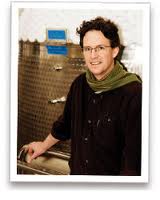
Scott began by discussing the general context starting with “Planet Earth”. Currently mankind is consuming 1.5 times the resources of the planet and at current projection will be soon be consuming double the planet’s resources. Clearly consumption is outstripping available energy.
Only 2% of that energy requirement is being fueled by the demand from information and communications technology (ICT). Intel wants to use their smarts to solve the problems in the other 98%. Looking at it from another perspective, mankind build it’s first billion personal computers sometime during the 3rd quarter of 2003. But we will have doubled the number of extant PC’s by 2014. However these computers will consume only half the energy while at the same time increasing their computing power 17 times.
Intel’s Eco-Tech innovation office
Intel’s Eco-Tech innovation office is a small group of people that are working across all business units to make the products more energy efficient and built in a sustainable manner. They are particularly focused on these areas:
- Water
- Buildings and home
- Transportation
- Extreme events
Intel has delivered a “proof of concept” of the home energy management product to the market. They are also developing technologies that will be able to listen to the current and “tease out” whether the appliance being used is a toaster or a hairdryer – within the next 2-3 years.
To do this requires some the development of some fundamental technologies.
These solutions can be designed along proprietary approaches, but Intel feels that to support more rapid diffusion of innovation this development should be done using open standards.
SG could help residences reduce energy consumption by 31%. SG could help commercial buildings by 10%. This means not just weatherizing, but also what you could do if you were able to provide real-time information. If the feedback units have the same technological basis you can deploy this capability across the world.
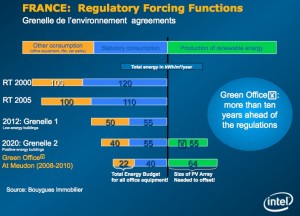 Bouygues Building project in France.
Bouygues Building project in France.
After 2020 French will require new commercial building to be “energy positive”. This is called the Grenelle d’Environment. This commercial complex is being built outside Paris. It’s currently rated as being “net 2 positive energy” – eight years ahead of the standard. They’re also exploring a micro-grid by tying together commercial 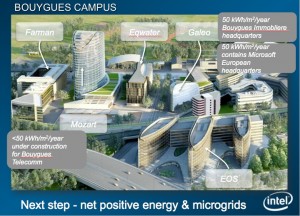 building in a commercial campus. They haven’t integrated any EV. The windows are double paned with argon filled with photo sensitive strips on the outside. They have installed 20,000 sensors in the building for 1,000 employees and tying it into the building management system – not to push the occupants but turning the lights off behind them.
building in a commercial campus. They haven’t integrated any EV. The windows are double paned with argon filled with photo sensitive strips on the outside. They have installed 20,000 sensors in the building for 1,000 employees and tying it into the building management system – not to push the occupants but turning the lights off behind them.
The Oregon Sustainability Center
PAE (Portland-based) did a study for the Oregon Sustainability building to understand how the energy use is distributed. The Sustainability Center is not a positive energy building. It’s designed to be a net zero: energy, net zero: water, and net zero: waste – within one year. The study showed what the typical consumption of a commercial building is. If you installed all the state-of-the-art energy efficiency you can save 63% of the energy – but you haven’t really engaged the tenants. To get up to 75% saving using the tenants you need to give them information about the impact of their behavior, or set policies. Intel is prototyping a personal energy interface, called POEM. Most people don’t like pie charts; Intel has adopted the garden as a visual metaphor for their personal energy manager. Intel will be proto-typing it with Bouygues Immobilier and the Oregon Sustainability is interested in it, too
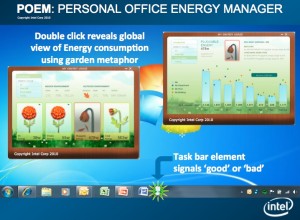 Behind the scenes these tools combine the information about how the building is operating. They’re working with Allen Bradley and Schneider to collect the building performance and they merging it together with the information that it coming from the IT sensor database. You can analyze the intersection of those two loads and get some interesting information about how to control the energy use. So far it’s not tied together with “health, life and safety” issues. But there is a clear use case for it since you have much finer grain information.
Behind the scenes these tools combine the information about how the building is operating. They’re working with Allen Bradley and Schneider to collect the building performance and they merging it together with the information that it coming from the IT sensor database. You can analyze the intersection of those two loads and get some interesting information about how to control the energy use. So far it’s not tied together with “health, life and safety” issues. But there is a clear use case for it since you have much finer grain information.
Intel is also working on similar techniques applied to water usage. That’s probably another 5 to 10 years in the future. Schull also referenced crowd-sourcing information for disaster management using cell phone information. Finally, he reviewed some of the seed investments that Intel is making to support innovative solutions.
_______________________________________________________________________________________

